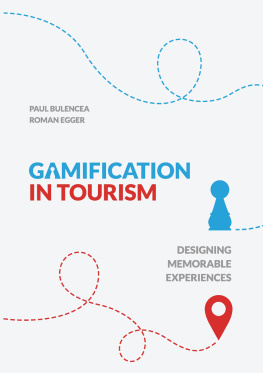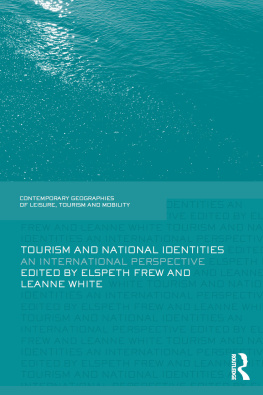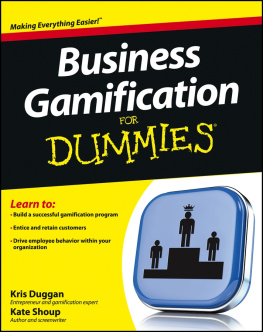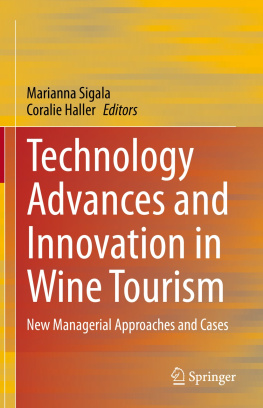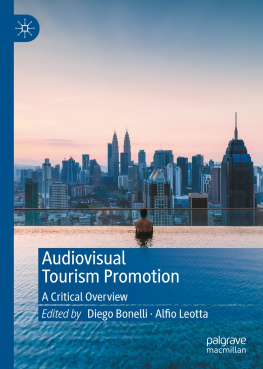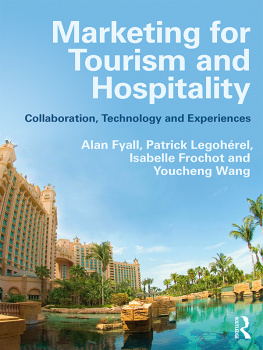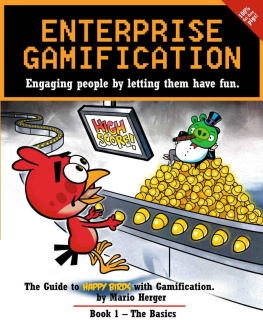Bibliographical information of the German National Library:
A catalog record for this book is available from the German National Library:
http://dnb.dnb.de
2015 Paul Bulencea, Roman Egger
Assisted by: Pamela Cheong
Illustration: Radu Luchian and George Rou
Partly financed by the Salzburg University of Applied Sciences
Production and Publisher: BoD Books on Demand GmbH, Norderstedt
ISBN: 9783739254524
Paul Bulencea
For my family that encouraged me to play and explore the world.
Roman Egger
For all my intrinsically motivated students who affirm that education is a fundamental right.
CONTENTS
INTRODUCTION
From a system designed to provide material satisfaction, we are rapidly creating an economy geared to the provision of psychic gratification.
Alvin Toffler
I n the 1970s, the futurist Alvin Toffler, regarded as one of the worlds most influential business voices (Accenture, 2002), wrote a book called Future Shock. Toffler performed a socio-economic analysis of the future and predicted that following the growth of the goods and the service-based economy, a new economic shift would occur. A new sector called the experience industries was envisioned, where experience designers would add a new psychological dimension to enhance the attractiveness of goods and services. For example, at the time, all women rejected a cake powder product that required only water to be baked. This product made the task of a housewife look too easy, eliminating any sense of achievement that could be derived from the cake baking process. The product was successful only after it was changed and required women to add an egg alongside with water to bake the cake. This is just one of Tofflers examples of why goods have to be designed in a psychologically compelling way, and that goods meant to reduce effort, time and labour, may not always be successful on the market. Similarly, the significance of psychological enticement can also be seen in services. For example, the airline industry that previously focused on getting customers from point A to point B, started competing on creating luxurious surroundings, hiring pretty stewardesses, providing food, in-flight movies, and some even created theme-specific flights. Thus, Toffler concluded that when people live under more affluent conditions and no longer struggle to meet their immediate material needs, the economy reorganises itself to deal with a new level of human needs.
Decades later in 1998, Pine and Gilmore published an article called Welcome to the Experience Economy. The experience industry that Toffler wrote about decades before, had materialised. Other authors also documented that the change that was predicted by Toffler, had happened. Holbrook and Hirschman (1982) referred to it in the experiential aspects of consumption: consumer fantasies, feelings, and fun; Schulze (1992) called this Die Erlebnisgesellschaft (the experience society) and finally, Jensens (1999) book The Dream Society, also explored this idea. Nevertheless, Pine and Gilmores conceptualisation is seen as having the most important impact, for creating an extensive interest in adopting and ).
Figure 1. Shifting Up the Progression of Economic Value
Source: Pine and Gilmore (1999, p. 72)
The inability to customise economic offerings and create product differentiation on the market is known as commoditisation (Increased competition, rapid technological developments and high customer expectations create an imperative for organisations that want to differentiate themselves on the market, to customise their offerings to the needs of their customers in order to avoid commoditisation.
Pine and Gilmores (1999) book about the experience economy was published in fifteen languages and purchased by more than three hundred thousand people worldwide from 1999 until 2011 However, Pine and Gilmore (2011) state that the book does not seem to have influenced enough business leaders and policy makers for them to focus on the new economic order of staging memorable experiences. An example of this is the one that Rory Sutherland, the vice-chairman of the advertising company Ogilvy Group UK, refers to in his TED talks (Sutherland 2009, 2011). For the Eurostar train project, 6 billion pounds were spent to reduce the journey time between London and Paris by forty minutes, from the original three and a half hours of journey time that the train needed. However, for a very small part of the budget WI-FI could have been installed on the trains that would not have reduced the duration of the journey, but would have enhanced the commuters experience. For approximately ten percent of the budget, the worlds top male and female supermodels could have been hired to walk up and down the train and serve passengers free Chteau Ptrus. Under this hypothetical situation, there would still be more than five billion pounds left in excess and people would ask for the train to be slowed down (Sutherland, 2011). This illustrates how business executives and politicians still seem to rely on goods manufacturing and services delivery, as the main thrust to fuelling economic growth. This logic also reflects a type of thinking where rational ideas are prioritised over psychologically enticing ideas (Sutherland, 2011). But the priorities will have to change as in recent years; goods and services are no longer sufficient to create new jobs, nurture economic growth and sustain economic prosperity (Pine and Gilmore, 1999).
It is an unequivocal fact that experiences are essential in the tourism industry (Sternberg, 1997; Canadian Tourism Commission, 2004). A tourism experience refers to an individuals subjective evaluation of events related to his touristic experiences that happen before, during and after the trip (Tung and Ritchie, 2011). Tourism primarily sells a staged experience and tourisms central productive activity [is] the creation of the touristic experience (Sternberg 1997, pp. 952,-954). However, while the design of these experiences has already been conducted for a while in tourism, it has been done in an unmanaged manner (Ritchie and Hudson, 2009, p. 120).
Tourists now desire for: their inclusion in unique activities, multi-sensory engagement and for mental, physical, emotional and intellectual stimulation (Canadian Tourism Commission, 2004, Morgan, Elbe and De Esteban Curiel, 2009). Moreover, due to changing customer demands, there is a risk of quality being taken for granted especially within mature tourism market services. The above phenomenon coupled with the advent of the Internet, means that commoditisation seems to be inevitable. Thus, one decides to purchase tourism products and patronise services mainly from the perspective of price consideration. All of these are aspects closely linked to the experience economy where the memorable experience acts as the main economic driver. Therefore, focusing on deliberately designing memorable experiences is essential as the future economic sustainability of the tourism industry is dependent on them.
On the other hand, game designers also aim to create experiences that are wonderful, compelling and memorable (Schell, 2008). The importance of such experiences can be seen in the emergence of digital games as an industry. Here, an exodus is underway as improvements in technology are turning virtual worlds into veritable dreamlands (Castronova, 2008). More and more people are choosing to engage in the virtual realms rather than with reality as hundreds of millions of people all over the globe and of all ages, are choosing to spend more and more time being engaged in video games (McGonigal, 2011a). McGonigal implies that reality compared to game worlds, is not carefully designed to make people happy, to motivate them effectively, to offer them enthralling challenges, pleasures, powerful social bonding or to maximise their potential. Thus, in comparison to what players can experience in game spaces/the virtual world, reality seems to be impoverished (McGonigal, 2013). Therefore, in order for reality to economically survive unchallenged, it will have to offer experiences similar to those in virtual worlds (Castronova, 2008).

